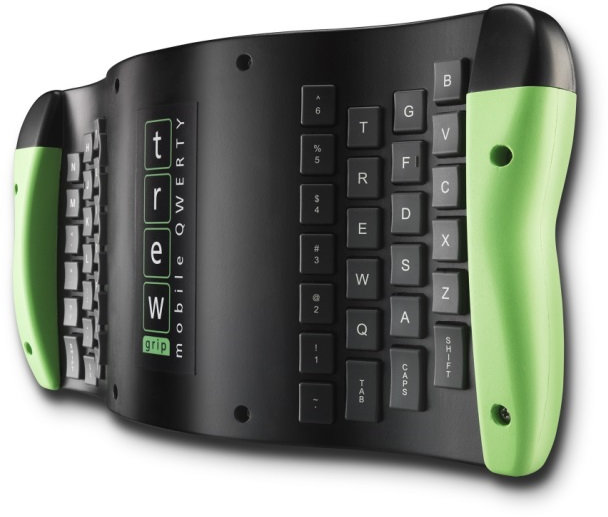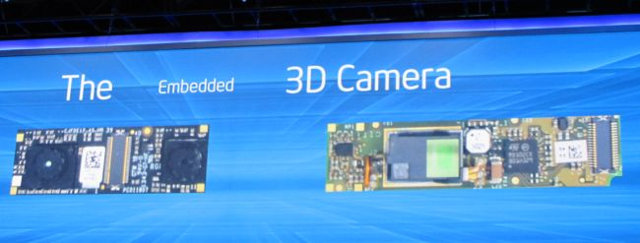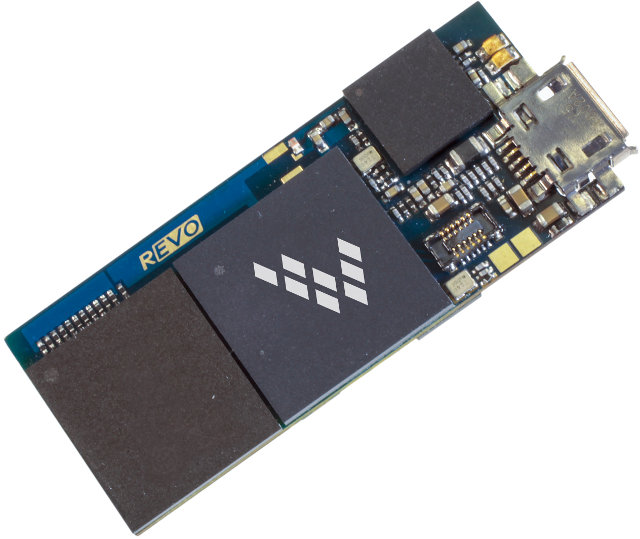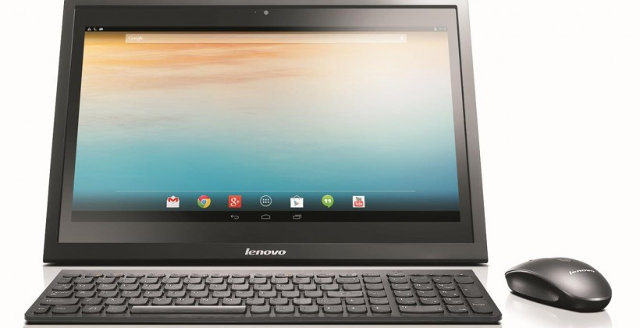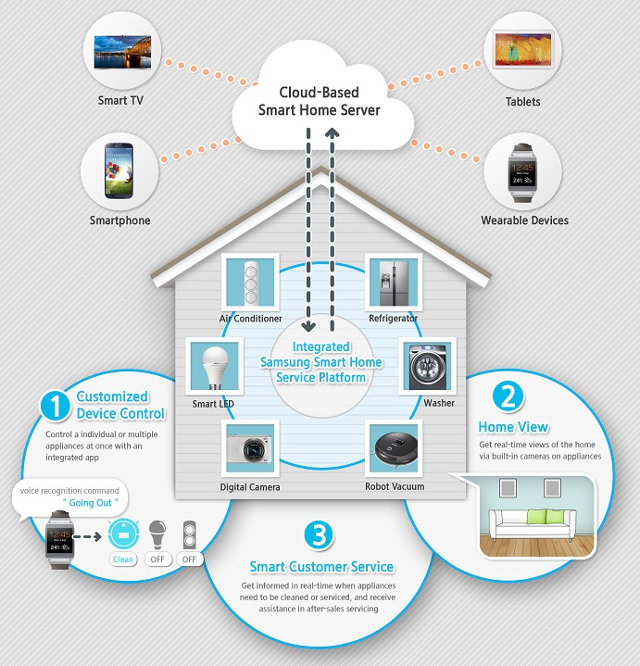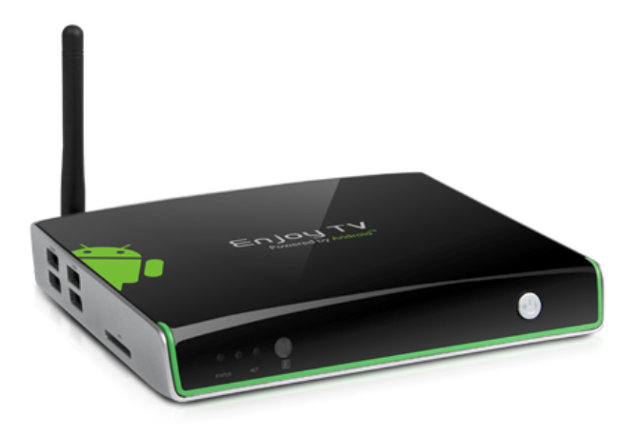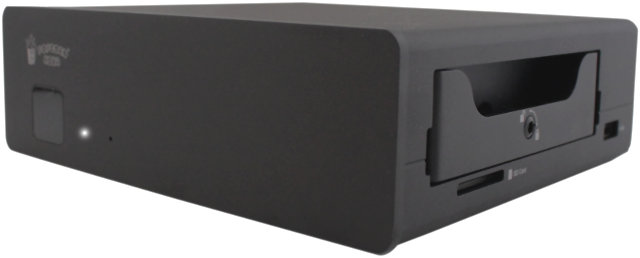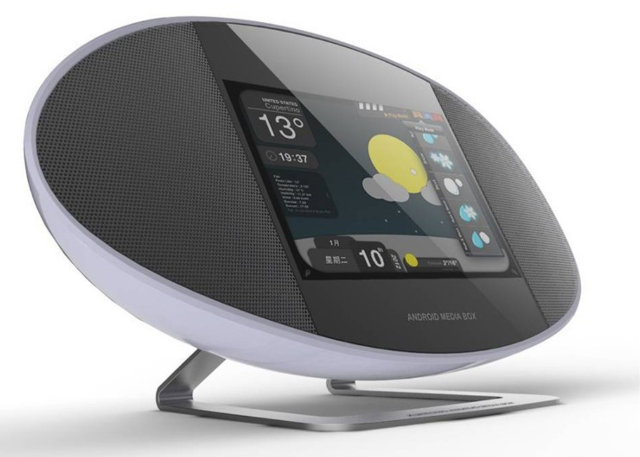Robert price can type 137 words per minutes on a desktop computer, and managed to achieve an amazing 115 words per minutes on a smartphone by using TREWGrip mobile qwerty keyboard. You may not be able to achieve the same speed yourself, but TREWGrip is an interesting portable wireless keyboard that should help you type much faster on your smartphone, or even mini tablets. It seems unintuitive at first, as the keys are actually located at the back of the keyboard as shown above, with illuminated indicator keys showing at the top showing where to type. The keyboard also have a 3-axis gyroscope to use it an an Air mouse. The keyboard communicates with your mobile device via Bluetooth classic. You’ll need some training to use this keyboard efficiently, but the company claims “the average user can achieve 90% of their QWERTY keyboard typing speed with only 8-10 hours of […]
Intel Unveils RealSense Technology with 3D Camera, Voice Recognition
Mooly Eden, Intel Senior Vice President and General Manager, gave a presentation at CES 2014 about Perceptual Computing, introducing Intel RealSense Technology that is currently comprised of a 3D “depth” camera, and Nuance Dragon Assitant voice technology in order to bring “Natural, Intuitive, and Immersive user experiences”. Dragon Assistant is a personal voice assistant that uses natural language understanding for Windows 8 Ultrabooks, notebooks, all-in-ones (AIOs), and tablet devices, and will be available in computers (Ultrabooks, AIO computer, and Tablets) from Acer, Dell, HP, Asus, Toshiba, and Lenovo in 2014. It’s very similar to what’s you’ve got with Siri on iOS or Google voice search, but the quick demo they’ve shown it could understand you without being specific. You awake the assistant by saying “Hey dragon”, and they tried with queries such as “I want to watch an episode of Family Guy” that started Hulu with a list of relevant […]
Freescale Announces WaRP (Wearables Reference Platform) Powered by Freescale i.MX 6SoloLite
We’ve seen more and more wearable products recently, be it smartwaches, smart rings, fitness bands, etc.., and we can expect several announcements at CES 2014 for wearables. Freescale has just launched their Wearable Reference Platform (WaRP), comprised of the WaRPboard, a tiny board based on Freescale i.MX 6SoloLite running Android, and a daughter board with KL16 Cortex M0+ MCU and several sensors. The main chips and corresponding features on the board are as follows: Freescale i.MX 6SoloLite Cortex A9 processor @ 1GHz with 2D graphics Vivante GC355 and GC320 GPUs. KL16 Sub-Family General Purpose Cortex M0+ MCU. Xtrinsic FXOS8700CQ, 6-Axis Sensor with Integrated Linear Accelerometer and Magnetometer. Xtrinsic MMA955xL Intelligent Motion-Sensing Platform. It cane be programmed to provide freefall detection, tilt and 3-D orientation detection, tap and double tap detection, dead reckoning, shock, vibration and sudden motion detection and power management. The company expect WaRP to be used in devices such as […]
Lenovo Introduces Nvidia Tegra based All-in-One Android Computers
Lenovo has unveiled two new Android computers just before CES 2014: N308 and ThinkVision 28, respectively powered by Nvidia Tegra 3 with a 19.5″ display and Tegra 4 with a 28″ UHD display. Lenovo N308 Lenovo N308 specifications: SoC – Nvidia Tegra 3 quad core Cortex A9 processor System Memory – 2GB RAM Storage – 8/16 GB SSD or 320/500 GB HDD, and 6-in-1 card reader Display – 19.5″ display (touch screen ??), 1600×900 resolution Connectivity – Wi-Fi and Bluetooth Webcam – Front camera for 720p video conference USB – 2x USB 2.0 ports Audio – Built-in stereo speakers, microphone, and headphone port Battery – Up to 3 hours of usage Lenovo computer cones with a keyboard and mouse, and runs Android 4.2.2 Jelly Bean. With a 19.45″ display, it’s not really portable, so the integrated battery is probably there to allow you to move it from one room to […]
Samsung Unveils “Samsung Smart Home” and Smart Home Software Protocol (SHP) at CES 2014
2014 could be the year where home automation becomes mainstream, as after Archos Connected Home, Samsung has now announced their own “Smart Home” service enabling users to control and manage their home devices, as well as Smart Home software Protocol (SHP) to enable connectivity between Smart Home products from Samsung and other manufacturers. Your smartphone, smartwatch (Galaxy GEAR), or smart TV will be the control center of your home, and you’ll be able to manage refrigerators, washing machines, smart TVs, lights, and more. Communication between your phone and the appliance will go through the company’s cloud-based Smart Home Server. At launch, Samsung will provide three main service features as shown in the illustration above: Device Control – Mobile devices or Smart TV can be used to monitor or control home appliances via Smart Home app from nearly anywhere. Voice control is also available so you could say “good night” to […]
Geniatech ATV1220 Dual Core Android TV Box with DVB-T Tuner Sells for $95 and Up
I’ve tested several Android TV boxes based on AMLogic AML8726-MX dual core processor including GBox Midnight MX2, Tronsmart Prometheus, or Jynxbox M6, that sell for about $90 to $120. Today I’ve been informed that Geniatech ATV1220 offers about the same hardware specs as the aforementioned devices, but adds a DVB-T tuner, and sells for $95 on ChinaVasion, or $99 on Mygica e-Store (Geniatech comsumer brand). Geniatech / Mygica ATV1220 Enjoy TV dual core hybrid box specifications: SoC – AMLogic AML8726-MX dual core Cortex A9 @ 1.5 GHz + Mali-400 GPU System Memory – 1GB DDR3 Storage – 4GB NAND flash + SD card slot Video Output – HDMI 1.4a, composite Audio – HDMI, stereo audio via RCA connectors. Antenna Input – Compliant with DVB-T, Frequency: TV 48.25 ~ 863.25 MHz. Connectivity – 10/100M Ethernet, Wi-Fi 802.11 b/g/n with external antenna USB – 4x USB 2.0 host ports Misc – IR […]
Popcorn Hour A-410 Linux Based Networked Media Jukebox is Now Available for Pre-order for $259
CloudMedia, previously known a Syabas, has announced the available of Popcorn Hour A410, a networked media jukebox (NMJ) powered by Sigma Designs SMP8911 dual core processor with 1GB RAM, Gigabit Ethernet, support for 2.5″ and 3.5″ SATA drives, USB 3.0, and numerous audio / video ports. It can be used as a media player, as well as a NAS (Networked Access Storage). Popcorn Hour A410 specifications: SoC – Sigma Designs SMP8911 Dual-Core 800Mhz processor (MIPS) with 512KB L2 Cache and VXP Video Processor System Memory – 1024MB DDR2 Storage – 256MB SLC NAND Flash, SD Card reader, 2.5″ and 3.5″ SATA HDD bay, and eSATA connector. Audio/Video I/Os – HDMI, Component, CVBS, Stereo Audio, optical and coaxial S/PDIF. Audio DAC – ESS Sabre Audiophile class DAC (24-bit, 192 Khz sampling rate) Video containers – MPEG1/2/4 Elementary (M1V, M2V, M4V),MPEG1/2 PS (M2P, MPG, DAT, VOB),MPEG2 Transport Stream (TS, TP, TRP, M2T, […]
Ampeq SoundPad 2 is an Android TV Box with a 7″ Tablet and Stereo Speakers
SoundPad 2, also known under the model name NA-307, is a tablet with a stand featuring two large (for a tablet) stereo speakers manufactured by Ampeq / Pan-Ocean Technology. The device can be used as a Bluetooth speaker, an Internet radio, and a standard Android TV box connected to your TV. It’s the first time I’ve come across this type of product, but Archos released a very similar item last year via its Arnova brand called, oh surprise!, SoundPad. Let’s have a look at SoundPad 2 specifications: SoC – Rockchip RK2928 cortex A9 processor with ARM Mali-400 GPU. System Memory – 1GB RAM Storage – 4GB flash + micro SD card slot Display – 7″ capacitive touch screen, 1024 x 600 resolution Video Output – HDMI Audio I/O – HDMI, 2x 3W 2″ HiFi speakers, microphone, 3.5mm audio Line IN. Connectivity – Wi-Fi 802.11 b/g/n, Bluetooth 2.1 + EDR USB […]


